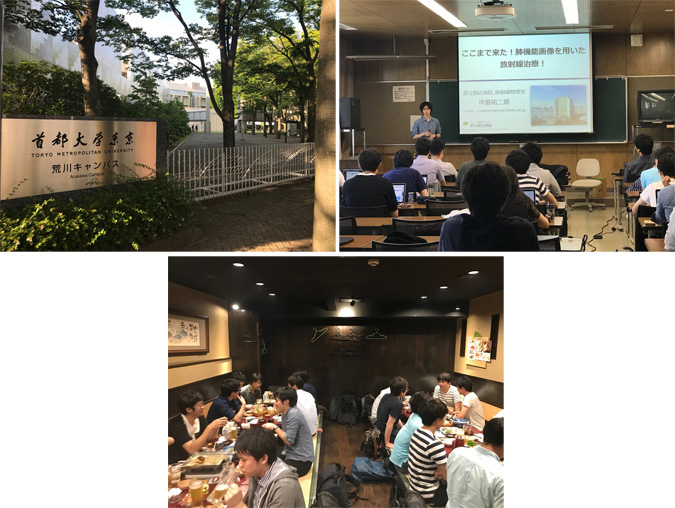2017.6.3:CMPFG46Th regular meeting
Dr. Nakajima (D2) has attended 46Th CMPFG regular meeting for presentation. Dr. Kadoya, Dr. Takayama (D1), Mr. Kanai (D3), Mr. Miyasaka (D1), Mr. Ieko (M2), Mr. Ishikubo (M1), Mr. kajikawa (M1), Mr. Sato (M1) and Mr. Matsumoto (M1) have attended it in Tokyo Metropolitan University, Tokyo, Japan on June 3, 2017.
■Date: 2017.6.3
■Venue: Tokyo Metropolitan University, Tokyo, Japan
■Conference name:46Th CMPFG regular meeting

Shinya Sato(M19
Dr. Nakajima, 2nd year PhD student, participated as a lecturer at the 46th regular meeting of CMPFG held on June 3, 2017 at the Arakawa Campus of Tokyo Metropolitan University, with Dr. Kadoya, Dr. Takayama, Mr. Kanai(D3), Mr. Miyasaka(D1), Mr. Ieko(M2), Mr. Ishikubo(M1), Mr. Kajikawa(M1), Mr. Satou(M1), Mr. Matsumoto(M1).
At the 46th regular meeting of the CMPFG, we listened to lecture-style presentations by four professors who have been leading the medical physics society, mainly from the Cancer and Infectious Diseases Center, Komagome Hospital. The morning session was about TBI, and the afternoon session was about ventilation, dynamic platform, and an incident at Komagome Hospital.
In recent years, radiation pneumonitis after radiotherapy has become a problem as the number of lung cancer patients increases. It has been reported that the frequency of radiation pneumonitis correlates with the dose to the high-functioning areas of the lungs, and ventilation is being actively studied worldwide. Many professors asked many questions during the lecture, indicating the high level of attention to this topic. We are currently conducting research on ventilation in our laboratory, and I thought I would make use of the knowledge I gained from this lecture in my future research. In this regular meeting, many lectures were given by professors with rich clinical experience, which was refreshing for those of us with no clinical experience. The lecture was based on actual cases of incidents, which were presented in the form of problems. Although the problems could not be solved without clinical experience, the lecturers were able to hear the actual points to pay attention to, the experiences of many doctors, and their approaches to countermeasures against incidents, which can be applied to clinical practice in the future. The reception that followed was also very meaningful, as we were able to deepen our discussions about future research and the Medical Physics Society with people from other facilities and schools.
Finally, I would like to take this opportunity to thank the doctors at the Cancer and Infectious Disease Center Komagome Hospital, the members of the Clinical Medical Physics Research Group, and the members of the Department of Radiation Science, Graduate School of Health Sciences, Tokyo Metropolitan University for providing us with such a valuable opportunity. Thank you very much.
